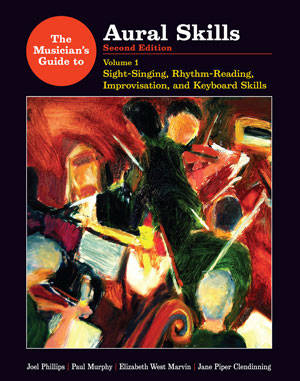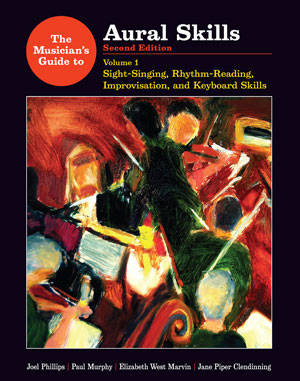Opens in a new window
W.W. Norton & Co. Inc The Musician's Guide to Aural Skills, Volume 1, Second Edition - Phillips /Murphy /Marvin /Clendinning - Book

Product Videos :
YouTube Video


YouTube Video


- Composer/Author: PHILLIPS/MURPHY/MARVIN/C
- Instrumentation: EAR TRAINING
- Model # 9780393442540
Authors: Joel Phillips, Paul Murphy, Elizabeth West Marvin, Jane Piper Clendinning
Format: Spiral Bound Book
Version: Ear Training Text
All the practical skills students need to succeed as professional musicians--in a single pedagogical program.
The Musicians Guide to Aural Skills integrates all critical aural skills in a single teaching and learning program coordinated (chapter by chapter) with a companion text in theory and analysis. The two volumes, organized by skill type, contain a wide range of exercises and a diverse repertoire of real musicclassical, popular song, film and TV themes, folk songs. There is absolutely no need for supplementary materials, and students are involved in creative music-making from the very beginning.
Volume 1 covers sight-singing, rhythm-reading, improvisation, and keyboard skills, corresponding to blocks of chapters in The Musician's Guide to Theory and Analysis, Second Edition. Students are able to acquire these essential performance skills at a pace that suits their own needs and abilities, with plenty of Listening Strategies to help them.
ABUNDANT EXERCISES
800+ sight-singing melodies include preparatory exercises, author-composed concept tudes, and melodies from the literature, from all periods and in all stylesmany of these ensemble excerpts in two, three, or four parts.
COMPREHENSIVE COVERAGE
600+ rhythm drills include basic patterns as well as graded rhythms for solo, duet, and trio. Guided individual and class improvisations encourage imaginative on-the-spot music-making.
PROGRESSIVE KEYBOARD EXERCISES
These exercises provide a solid foundation in keyboard harmony and bring to life the harmonic models explained in The Musicians Guide to Theory and Analysis, Second Edition. Beginning with simple paradigms and extending through chromatic harmony, the exercises facilitate a spiral-based learning approach, allowing students to connect a new concept to the one they already know.
Contents:
PART I: ELEMENTS OF MUSIC
- Sight-Singing
- Major-key melodies in simple meters
- Major- and minor-key melodies in simple and compound meters
- Major- and minor-key melodies in simple and compound meters with beat subdivisions
- Modal melodies
- Rhythm-Reading
- Simple meters: The beat and its division
- Compound meters: The beat and its division
- Simple meters: Adding beat subdivisions
- Compound meters: Adding beat subdivisions
- Simple and compound meters with borrowed beat divisions ("tuplets")
- Sight-Singing
- Phrases
- Embellishing phrases
- Phrase organization
- Tonicization
- Rhythm-Reading
- Simple meters: Eighth-note, quarter-note, and half-note beat units with subdivisions
- Compound meters: Dotted-eighth-, -quarter-, and -half-note beat units with subdivisions
- Compound triplets in simple meters: Ensemble exercises
- Compound duplets in simple and compound meters: Ensemble exercises
- Hemiola
- Combined beat divisions in simple meters
- Combined beat divisions in compound meters
- Sight-Singing
- Tonicizations, modulations, and small forms
- More contrapuntal music, modal mixture, and the N6 and A6 chords
- New vocal forms, more chromatic harmonies, and larger forms
- Rhythm-Reading
- Changing meters
- Super-subdivided beats in slow tempos
- More syncopation: Ragtime and jazz
- Asymmetric meters
- Combined beat divisions (3:4): Two-part and ensemble rhythms
- Sight-Singing
- Modal and pentatonic melodies revisited
- Precursors to atonal music: Collections and sets
- Ordered collections and twelve-tone music
- More rhythmic challenges
- Rhythm-Reading
- Other tuplets
- More asymmetric meters
- Characteristic dance rhythms
- Rhythms of the spoken word
- Tempo and meter modulation
- Twentieth-century concepts and excerpts
Improvisation
- Lesson 1: Rhythmic cells
- Lesson 2: Major and minor triads
- Lesson 3: Major- and minor-key melodies
- Lesson 4: Major pentatonic, minor pentatonic, and modal melodies
- Lesson 5: Seventh chords
- Lesson 6: First-species counterpoint
- Lesson 7: Second-species counterpoint
- Lesson 8: Embellishing melodic outlines
- Lesson 9: Improvising melodies in phrase pairs
- Lesson 10: Improvising over figured basses and Roman numeral progressions
- Lesson 11: Conclusive and inconclusive phrases
- Lesson 12: Improvising with predominant chords
- Lesson 13: Improvising periods
- Lesson 14: Improvising sequences
- Lesson 15: Phrase expansion, asymmetrical meter, and tonicization
- Lesson 16: Modulatory periods
- Lesson 17: Mixture, phrase expansion, A6 and N6 chords
- Lesson 18: Blues and rock
- Lesson 19: Continuous variations
- Lesson 20: Ragtime
- Lesson 21: Modes and scales
- Lesson 22: Whole-tone and pentatonic scales
- Lesson 23: Octatonic scales and subsets
- Lesson 24: Twelve-tone dance
- Lesson 25: Polymetric duets
- Lesson 1: Major pentachords, tetrachords, and scales
- Lesson 2: Minor pentachords, tetrachords, and scales
- Lesson 3: Diatonic modes
- Lesson 4: Intervals
- Lesson 5: Triads
- Lesson 6: Seventh chords
- Lesson 7: Counterpoint
- Lesson 8: The basic phrase-tonic- and dominant-function chords
- Lesson 9: Adding predominant chords to the basic phrase
- Lesson 10: Dominant-function seventh chords
- Lesson 11: More dominant-tonic (D-T) progressions
- Lesson 12: Predominant expansion of the tonic
- Lesson 13: Deceptive and Phrygian resolutions
- Lesson 14: Delayed resolutions
- Lesson 15: Sequences
- Lesson 16: Secondary-dominant-function chords
- Lesson 17: Common modulations
- Lesson 18: Modal mixture
- Lesson 19: Blues and popular music harmony
- Lesson 20: Other chromatic harmony
- Lesson 21: Unordered pitch-class sets
Media
Youtube video product demo
Youtube video product demo
Q & A
There are currently no questions for this product.
Reviews
There are currently no reviews for this product. Be the first to write one!




